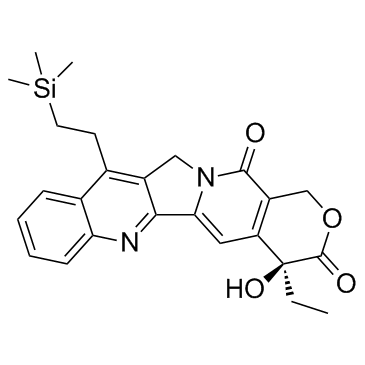| Description |
Karenitecin (Cositecan) is a topoisomerase I inhibitor, with potent anti-cancer activity.
|
| Related Catalog |
|
| Target |
Topoisomerase I
|
| In Vitro |
Karenitecin is a topoisomerase I inhibitor, with potent anti-cancer activity. Karenitecin inhibits cell growth of A253 cells with IC10, IC50, and IC90 values of 0.01, 0.07, and 0.7 μM after 2 h treatment. Karenitecin induces DNA damage (0.01, 0.07, and 0.7 μM), and increases cyclin E and cdk2 protein expression in A253 cells (0.07, and 0.7 μM). Karenitecin markedly enhances the cyclin B/cdc2-associated kinase activity at low concentration, but slightly suppresses this kinase activity at higher concentration[1]. Karenitecin inhibits several human colon cancer cell lines such as COLO205, COLO320, LS174T, SW1398 and WiDr cells, with IC50s of 2.4 nM, 1.5 nM, 1.6 nM, 2.9 nM, and 3.2 nM, respectively[2].
|
| In Vivo |
Karenitecin shows maximum growth inhibition of 61% on COLO320 cells and 54% on COLO205 colon cancer cells via i.p. administration of 1 mg/kg in mice. Karenitecin (1.0 mg/kg daily × 5 i.p.) significantly suppresses growth inhibition both in the parental Pgp-negative xenografts and in the Pgp-positive xenografts[2].
|
| Cell Assay |
sup>[1]Cell growth inhibition is determined using the total protein SRB assay as described elsewhere. Briefly, 600 cells/well are seeded onto 96-well plates. After 24 h, exponentially growing A253 cells are treated with Karenitecin, which is diluted in culture medium, for 2 h. At four doubling times after drug exposure, the cells are fixed with 10% trichloroacetic acid and further processed according to the published SRB procedure. The optical density is measured at 570 nm. Antiproliferative activities are expressed as drug concentrations that induce growth inhibition of 50 or 90% compared with growth of untreated controls (IC50 and IC90 values)[1].
|
| Animal Admin |
Mice[2] The human tumor xenografts grown in nude mice are measured twice a week in 3 dimensions with vernier calipers. The volume is calculated by the equation length × width × thickness × 0.5, and expressed in mm3. At the start of treatment (designated as day 0), groups of 5 to 6 tumor-bearing mice are formed to provide a mean tumor volume of approximately 150 mm3 in each group. Doses of Karenitecin and CPT-11 for the daily × 5 schedule are administered according to the maximum tolerated dose (MTD) for tumor-bearing mice. This maximum tolerated dose is based on the occurrence of a mean weight loss of approximately 10% of the initial weight within the first 2 weeks after the start of the treatment. Recovery of the weight loss should be completed on day 14; consequently, mice are weighed on weekdays for 2 weeks and, thereafter, twice a week. The MTD is assessed in groups of 3 non-tumor-bearing nude mice per dose level[2].
|
| References |
[1]. Yin MB, et al. Characterization of protein kinase chk1 essential for the cell cycle checkpoint after exposure of human head and neck carcinoma A253 cells to a novel topoisomerase I inhibitor BNP1350. Mol Pharmacol. 2000 Mar;57(3):453-9. [2]. Van Hattum AH, et al. New highly lipophilic camptothecin BNP1350 is an effective drug in experimental human cancer. Int J Cancer. 2000 Oct 15;88(2):260-6.
|
